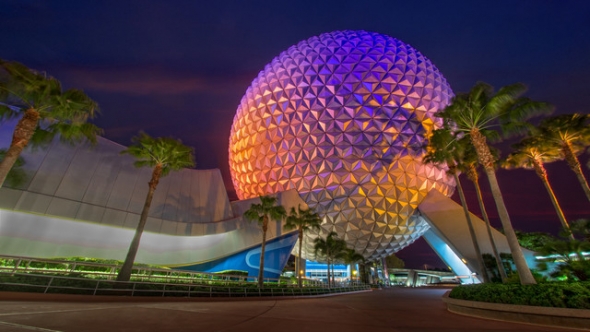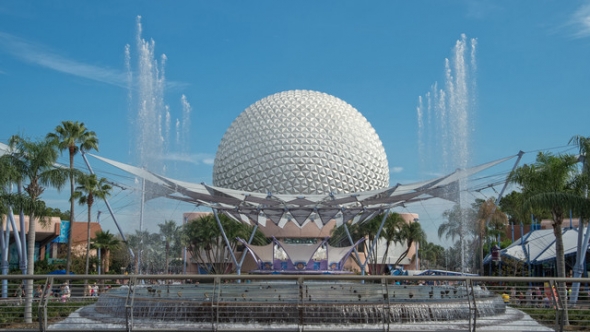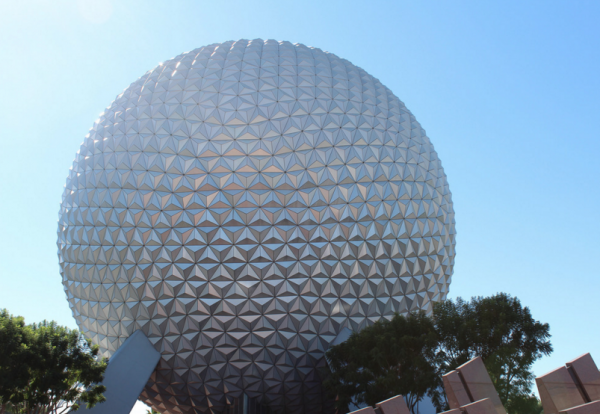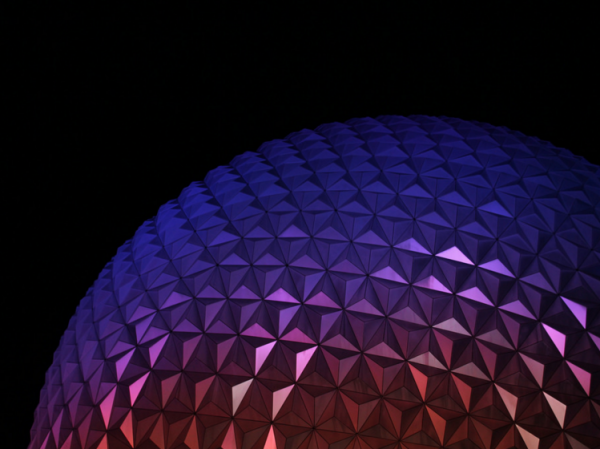Spaceship Earth
Image: Disney
In the early 1980s, giant steel balls were all the rage in society. Okay, there were at least two under construction. One was in Knoxville, Tennessee, where engineers readied an absurd looking hexagonal steel ball for the 1982 World’s Fair. It was called the Sunsphere, and it’s a punchline inasmuch as a lasting legacy to architecture. People quickly realized that using gold dust to layer glass panes would cause intense heating issues inside the building. That structure debuted in May of 1982 and was already a laughing stock by the end of the year.
A few months later on October 1, 1982, EPCOT Center (as it was originally known) opened to the public. The jaw-dropping piece of architecture called Spaceship Earth stood mightily near the front gates, drawing attraction from all the people ready to storm the entrance to enjoy all the futuristic sciences and technologies that Disney promised of EPCOT Center. Suffice to say that this giant ball has stood the test of time a bit more easily than the earlier arriving Sunsphere despite that the themes are similar. In other words, placing some of the finest engineering minds in the world against Disney’s Imagineers proved to be a blowout.
The key, as always, is that Disney employees anticipated concerns that people without experience in novelty engineering couldn’t have expected. They debated many structural builds, each of which was capable of dazzling onlookers, before settling on one that wasn’t just breathtaking to view. It was also feasible to construct and easy to utilize as a ride attraction. It’s that kind of forward-thinking that explains why Spaceship Earth is as remarkable today as it was almost 35 years ago when construction began.
Pentakis dodecahedron? Seriously?
Image: Disney
While you’d need the world’s largest driver to strike this particular golf ball, and only Godzilla would be large enough to swing it, there’s no disputing the look of Spaceship Earth. It looks like a giant golf ball complete with dimples. Like so many triumphs of aesthetics, it looks completely different up close than it does from afar. That’s because of the unique infrastructure.
Warning: there are many strange words ahead.
The giant ball you know as Spaceship Earth has a geometric basis for its design, and one that sounds like a James Bond villain at that. It’s called a pentakis dodecahedron, which means that it’s got a series of 12-faced regions. A set of five triangular faces, each of them in a pyramid design, pairs with each dodecahedron.
Disney Imagineers modified the concept slightly to create the novel look you know today. Their giant ball includes 60 isosceles triangle faces that are then split into 16 even smaller triangles. Due to all the splits and cuts, we wind up with just under 1,000 flat panels (960 to be precise) totaling 11,520 triangles. All of them meet at 3,840 points. You can’t see some of them due to side concerns for the building such as entry points. Then again, it’s not like you were going to count all the way up to 11,000 anyway.
Don’t worry. You’re not going to be tested on any of this. It simply underscores how complex the underlying design of Spaceship Earth is. Think of the entire structure as one giant SAT exam with a focus on your least favorite subject, geometry. If you find Hidden Mickeys searches obsessive, discovering all the triangles in the Spaceship Earth façade might drive you insane.
Less math, more facts
Now that you feel like a teacher’s pet for knowing all the math of Spaceship Earth, let’s focus on the construction. For all its complicated calculus, the actual building of the facility didn’t take a lot of time. Disney completed the entire process in just over two years. The 26-month endeavor is a remarkable turnaround time for something that stands 182 feet tall and 165 feet wide. Note that Disney didn’t feel the need to best its own records. They intentionally left Spaceship Earth seven feet shorter than Cinderella Castle, leaving it as the tallest park landmark for a long time.
What did Disney need in terms of raw materials to bring Spaceship Earth into reality? Well, it’s more than you’ll find at your local Home Depot. The theme of Epcot during its early days was “bringing the world together through technology,” but raw materials must have been implied. Massive volumes of aluminum, plastic, and steel comprise the core. The design of the building is so strange that Disney had to build it in three parts.
The three sections were the sphere portion, the utility portion, and the ride itself. Obviously, the ride and show portion had to fit inside the sphere part, which added a level of complexity to an otherwise seamless process. For the ride, Disney built a floor unit with concrete slabs supported by metal decking. The utility portion does most of the heavy lifting in a literal sense. It handles the load transfers for both the sphere and the ride, thus the name utility.
Trying to reason with hurricane season
Due to the novel design of a geodesic sphere, Disney had to perform several research studies on feasibility. They were especially worried about the weather conditions in Orlando, Florida. Disney asked MIT to perform wind test studies on a smaller scale version of Spaceship Earth specifically built for testing purposes. Disney employees needed to make sure that guests walking around the base of the structure wouldn’t have anything ridiculous happen. There were early concerns that wind might knock guests off their feet. Thankfully, those worries proved unfounded.
Disney still wasn’t done worrying about the weather, though. Imagineers calculated the potential flooding issues, particularly during hurricane season. It’s true that if you stand directly under Spaceship Earth, you won’t get wet. This is a feature, not a bug. One of the hidden purposes of the many, many triangles is that they drain water in a way that shields guests from moisture. Spaceship Earth is more than an architectural triumph. It’s also a giant umbrella.
Finally, in order to create the floating effect of the ball, Disney put it on stilts. Yes, I’m serious. The actual structure stands 18 feet above the ground. That’s because a series of six steel legs provide its balance. They are built 160 feet into the ground to provide maximum support for a facility that weighs an almost incomprehensible 7,760 tons. That’s the equivalent of 130 elephants. Eat your heart out, Animal Kingdom!
In the era of multi-billion dollar purchases such as Pixar and Star Wars, we sometimes forget that Disney once faced significant budgetary constraints. Even after they took on $400 million in debt, they continued to find ways to increase the value of their theme parks for visiting guests. Many of the architectural triumphs we take for granted today wouldn’t have been possible for even the best designers of that era, even if they’d had limitless budgets. Disney’s Imagineers continually turned seeming disadvantages such as limited financing, governmental regulations and lack of raw materials into long-term advantages. Rather than be dissuaded from their ultimate goal of building these majestic attractions, they simply prioritized the ones that were more feasible in the short-term. Then, once they had more money and benefited from technological advances, they crafted better rides in the same locations. When you visit Walt Disney World, every architectural accomplishment is also a monument to the ingenuity and perseverance of Disney Imagineers.





Comments
Good article.
What surprises me is how quickly the new attractions were constructed (after finally deciding, of course). We are now looking at 3+ years before Pandora is open to the public, and its likely Star Wars land won't be open for another 4 years. I know these are themed areas and not just a single attraction, but I would think advancements in construction technology would speed things up a bit.